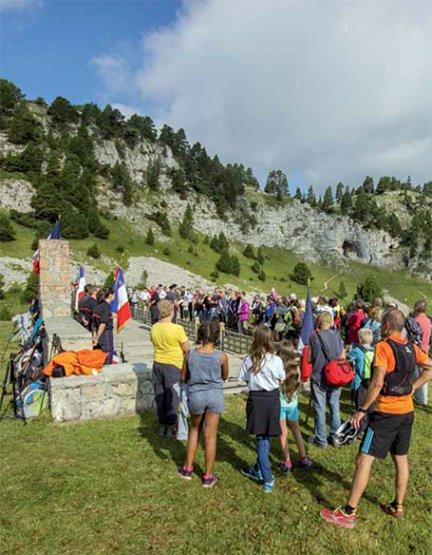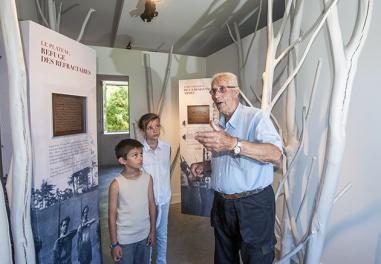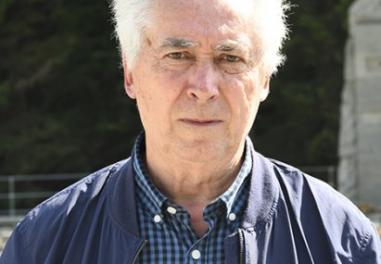A new national cemetery in Vercors
In 2018, the French State will acquire the Pas de l’Aiguille site, in the department of Isère, the 274th military cemetery to come under the responsibility of the Ministry of the Armed Forces. This will complete the process of acquisition of the three cemeteries in Vercors, begun in 2014.

The Vercors plateau, which rises to a height of 2 300 metres, has the appearance of a natural fortress, 60 km long and 30 km wide. In 1940, the site became a refuge for all those who were victims of the repressive measures of the occupier and the Vichy regime. With the invasion of the southern zone by the Germans in November 1942, Vercors became a centre of resistance for those who rejected the idea of a subservient France.
VERCORS, A TRAGIC EPIC
In 1942, the idea emerged that Vercors might support the Allied landings expected in Provence. Captain Alain Le Ray was charged with drawing up the Plan Montagnards, whose execution was entrusted to squadron commander François Huet, Vercors’ military commander in 1944, and Eugène Chavant, the maquis’ civilian leader. By early 1944, there were nearly 400 maquisards in Vercors. This natural citadel was becoming a threat to the enemy.
On 6 June 1944, Vercors responded to the order for general mobilisation. The message broadcast by Radio Londres gave the signal for armed action. Volunteers flocked here in response, so that there were a total of 4 000 by July. The Republic was restored and the French flag flew over this territory declared “free”. With support from General Pflaum, General Niehoff, Wehrmacht commander for the southeast, decided to break the resistance. The first confrontations took place in Saint-Nizier-du-Moucherotte, on 13 and 15 June 1944. Several hundred maquisards initially stood their ground against the German troops, but were forced to retreat when the enemy returned on 15 June with more than 3 000 men.
The village fell into the hands of the Wehrmacht, who showed no mercy, killing the wounded and setting fire to homes. Just 11 of the village’s 93 houses escaped destruction. The decisive blow was dealt on 21 July, at Vassieux-en-Vercors. The Germans attacked on all sides: by road, over the mountain passes and by air. Over 10 000 soldiers invaded the plateau.
All across Vercors (at Pas de l’Aiguille, Valchevrière, La Croix Perrin), fighting raged between the enemy and the maquisards. After days of combat, orders were given for the maquis to disperse. More than 600 Resistance fighters and one hundred Germans were killed. The civilian population also paid a heavy price: 201 people were killed or executed, 41 others deported and 573 houses were destroyed. On 4 August 1945, Vassieux-en-Vercors was decreed a “Companion Town of Liberation”, a rare honour accorded to only four other communes: Paris, Nantes, Grenoble and Île-de-Sein. The maquisards of Vercors went on to fight in the First Army.
All of these sites today still bear the scars of 1944, and have been transformed into places of remembrance by local actors and the Ministry of the Armed Forces Directorate for Heritage, Remembrance and Archives (DPMA).
THOSE WHO “DIED FOR FRANCE”
At the end of the war, three cemeteries were built by the National Association of Volunteer Combatants and Pioneers of Vercors (ANPCVV). In the hills above Grenoble, the cemetery of Saint-Nizier-du-Moucherotte contains the remains of soldiers and maquisards who “died for France” in the fighting of June 1944. Ninety-eight Resistance fighters are buried there, and among them stand the tomb of Eugène Chavant and the cenotaph of François Huet.
The cemetery of Vassieux-en-Vercors contains the graves of 80 maquisards, 58 inhabitants of Vassieux and 49 unknown soldiers killed in the fighting of July 1944. The metal structures of two gliders, used by the Luftwaffe on 21 July, are preserved on the site. There is a “remembrance room”, in memory of all the victims of Vercors, and a plaque which tells how the body of Sergeant Raymond Anne, a maquisard from Vassieux, lies in the crypt of Mont Valérien, as a symbol of the sacrifice of all those maquisards who gave their lives for France. More than 1600 metres above sea level, the cemetery of Pas de l’Aiguille, in the commune of Chichilianne, holds the graves of seven Resistance fighters and one shepherd killed in the fighting of 21 to 24 July 1944.
DEVELOPING THE NATIONAL CEMETERIES
In 2014, on the 70th anniversary of the fighting in Vercors, the ANPCVV decided to transfer ownership of these sites to the State, which already maintained them, for them to be made into national cemeteries. The cemeteries of Saint-Nizier-du-Moucherotte and Vassieux-en-Vercors passed into State hands in 2015, and the Pas de l’Aiguille site, the smallest, highest-altitude cemetery in France, will do so this year.
As part of its remembrance policy, the DPMA funds the upkeep and restoration of these cemeteries according to three principles: the application of a landscaping charter, introduced in 2015; the use of more environmentally friendly maintenance methods, with the entry into force of the ‘Zero Pesticides’ plan in 2017; and the implementation of a ‘Planned Accessibility Agenda’ for these remembrance sites. Since 2014, the graves at the cemetery of Saint-Nizier-du-Moucherotte have been adorned with badges bearing the emblem of the ‘Pioneers’, and a series of works have been carried out on the external walls of the cemeteries. A flagpole is to be erected at the cemetery of Pas de l’Aiguille in 2018.
To encourage remembrance tourism, historical information panels have been installed in each of the cemeteries. Meanwhile, the ‘Remembrance Room’ at Vassieux-en-Vercors now has an interpretation area. A frieze explains the role and history of the Vercors Pioneers. A permanent exhibition, Visages du Vercors (Faces of Vercors), was opened in July 2017 on the edge of the cemetery, which pays tribute to the maquisards and civilians who took part or were killed in the fighting.
Finally, the DPMA and its operator, the National Office for Veterans and Victims of War (ONAC-VG), signed a framework agreement with the commune of Vassieux-en-Vercors, the Vassieux-en-Vercors Resistance Museum, the Vassieux-en-Vercors Memorial and the ANPCVV, aimed at fully integrating these remembrance sites with the local tourism fabric and supporting local actors in their regional development activities. A similar agreement has been signed for Saint-Nizier and will be for Pas de l’Aiguille. In this way, the DPMA demonstrates its desire to work in partnership with local stakeholders to preserve the spirit of these sites. In 2019, a tourism brochure presenting these three cemeteries will be published.
Read more
Articles of the review
-
The file

Remembrance tourism in Auvergne-Rhône-Alpes
The Second World War left deep scars on the Auvergne-Rhône-Alpes landscape. Today, the region tells its story through its museums, memorials and history centres, all of which are coordinated at regional level by Réseau Mémorha to ensure the consistency of their cultural and remembrance offering. ...Read more -
The figure

Nantua Museum
In a redesigned layout, accessible to all, the Ain Museum of the Resistance and Deportation gives an up-to-date interpretation of the events of the Second World War, through the experiences of the inhabitants of the Ain and the strategic issues of importance to the department.
Read more -
The interview

Gérard Métral
Il est le fils d’Alphonse Métral, l’un des fondateurs de l’association des Rescapés des Glières. Après des études en arts plastiques à Paris, il est l’assistant du sculpteur Émile Gilioli, auteur du Monument national à la Résistance des Glières et il préside aujourd’hui l’association des Glières. ...Read more

